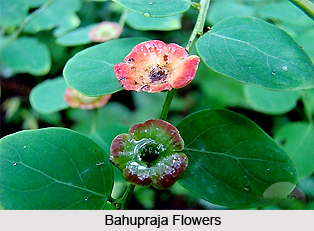 Breynia retusa is the Botanical name of Bahupraja. Bahupraja plant mainly grows in open forests and scrublands in the tropical Himalayas from Nepal to Manipur and in peninsular India to an altitude of 1500 m. Although this Indian medicinal plant has its origin in Myanmar and Sri Lanka. Bahupraja is referred with various other names in different parts of India like in Bengali: Chitki; Gujarati: Kamboi; in Hindi: Kalamahomad, Kambhi, Kedakamboi, Khedakamboi; in Malayalam: Peruniruri; in Marathi: Kalichikali, Kangli; in Oriya: Deu-Lopohora, Jajan, Jajanga, Medhokotahotoru; in Sanskrit: Bahupraja, Kamboji; in Tamil: Pavalapulah and in Telugu: Devadari.
Breynia retusa is the Botanical name of Bahupraja. Bahupraja plant mainly grows in open forests and scrublands in the tropical Himalayas from Nepal to Manipur and in peninsular India to an altitude of 1500 m. Although this Indian medicinal plant has its origin in Myanmar and Sri Lanka. Bahupraja is referred with various other names in different parts of India like in Bengali: Chitki; Gujarati: Kamboi; in Hindi: Kalamahomad, Kambhi, Kedakamboi, Khedakamboi; in Malayalam: Peruniruri; in Marathi: Kalichikali, Kangli; in Oriya: Deu-Lopohora, Jajan, Jajanga, Medhokotahotoru; in Sanskrit: Bahupraja, Kamboji; in Tamil: Pavalapulah and in Telugu: Devadari.
Bahupraja has membranous, distichous, broadly elliptic to orbicular and apex obtuse leaves. Flowers of this Bahupraja plant have small young leaves with axillary on filiform pedicels where male flowers is in the lower and female flowers is in the upper axils. Male Bahupraja flowers are pale yellow with smaller alternative lobes. Female Bahupraja flowers are pale green with pedicles shorter than male flowers. Bahupraja fruits are flattened at both sides. These fruits become orange red with an enlarged calyx when ripe. Seeds of Bahupraja plants are triquetrous and blue-grey in colour with orange-yellow aril.
In Ayurveda, Bahupraja plant is known for its astringent qualities to the bowels. It can be used to cure blood diseases and inflammation. Juice of Bahupraja stem helps in curing conjunctivitis. Bahupraja leaves are considered as poultice to hurry suppuration of infected sores. In southern Orissa, leaf bud or young leaf of Bahupraja is consumed orally to cure diarrhea.



















